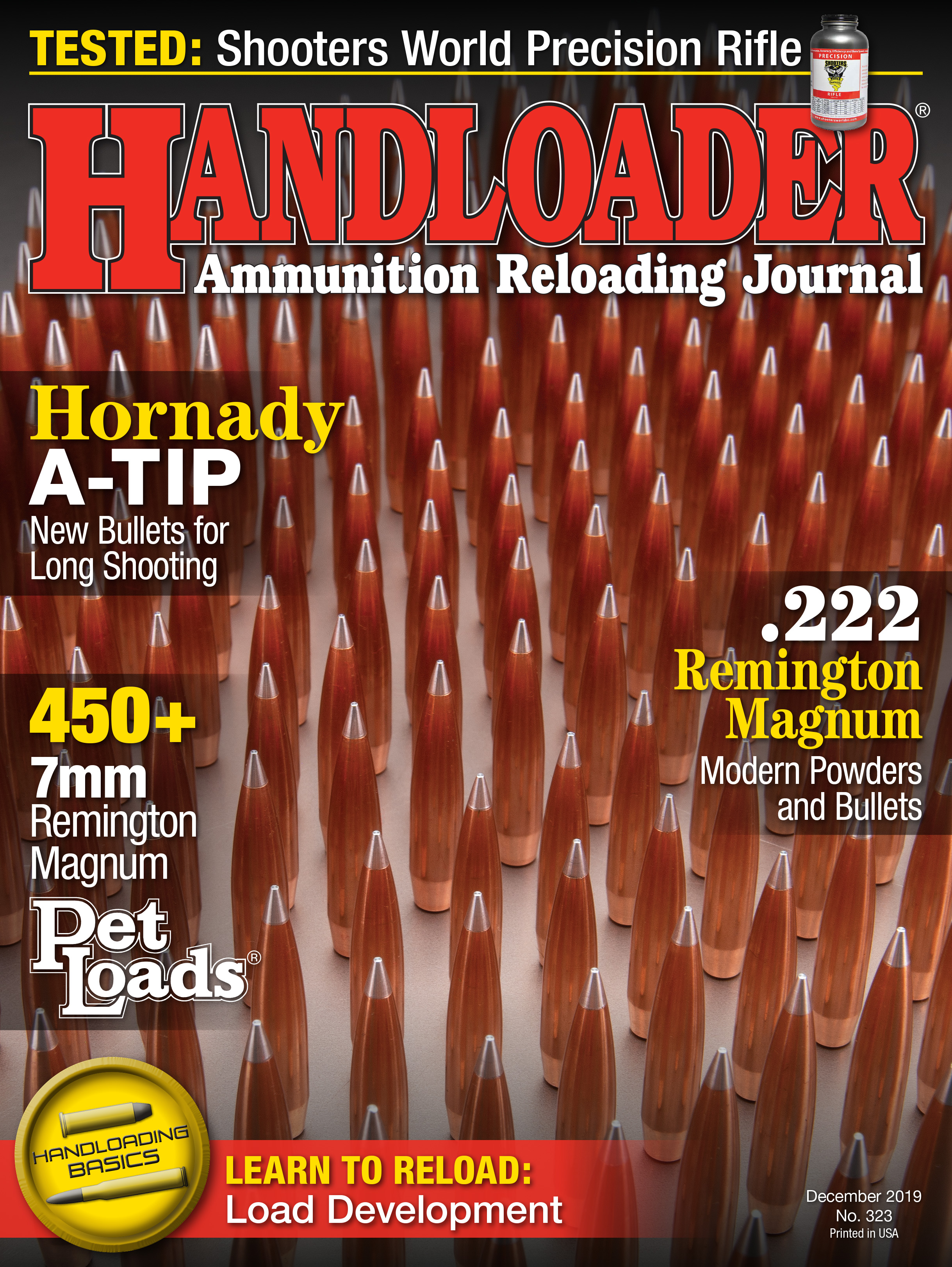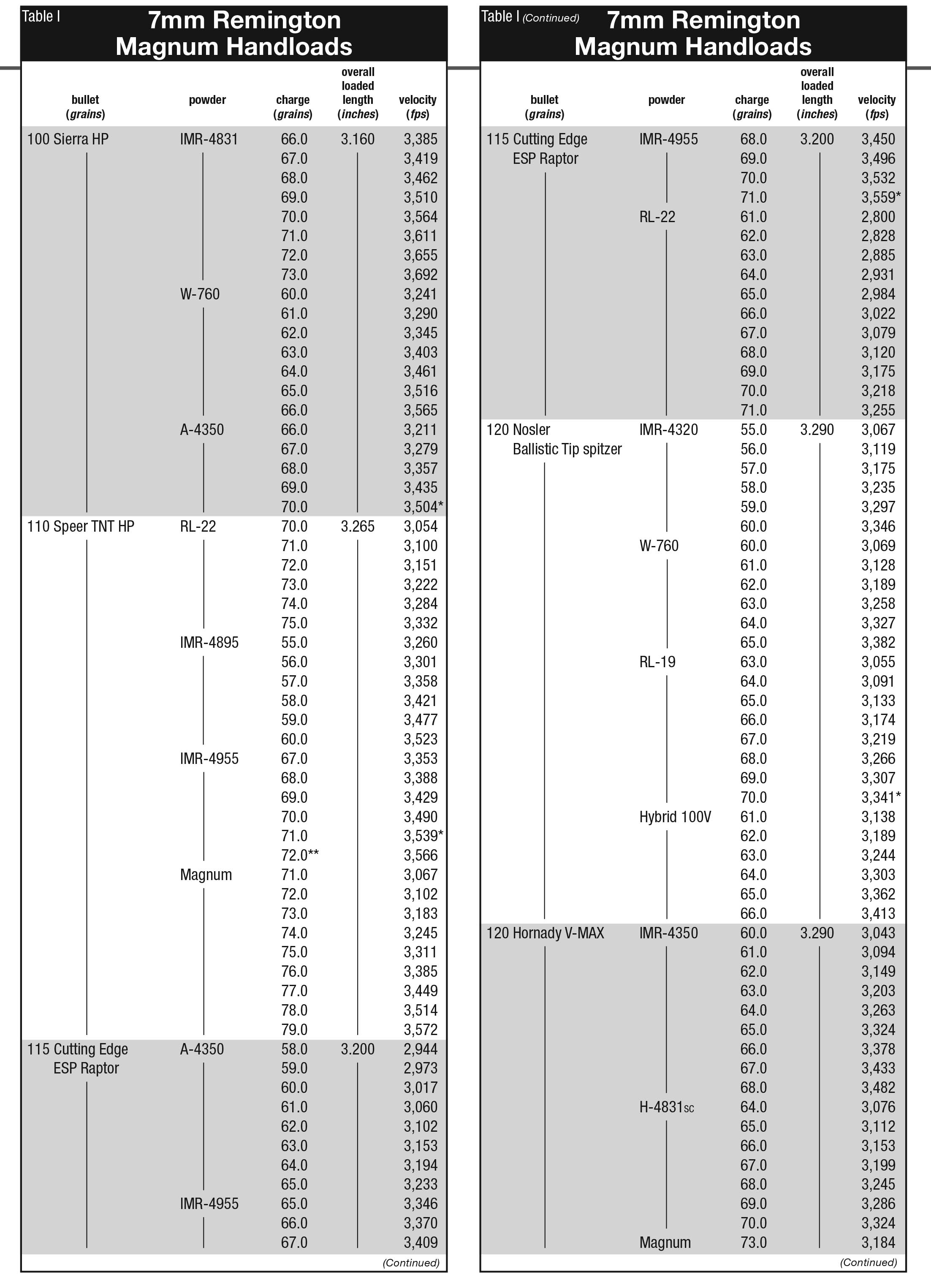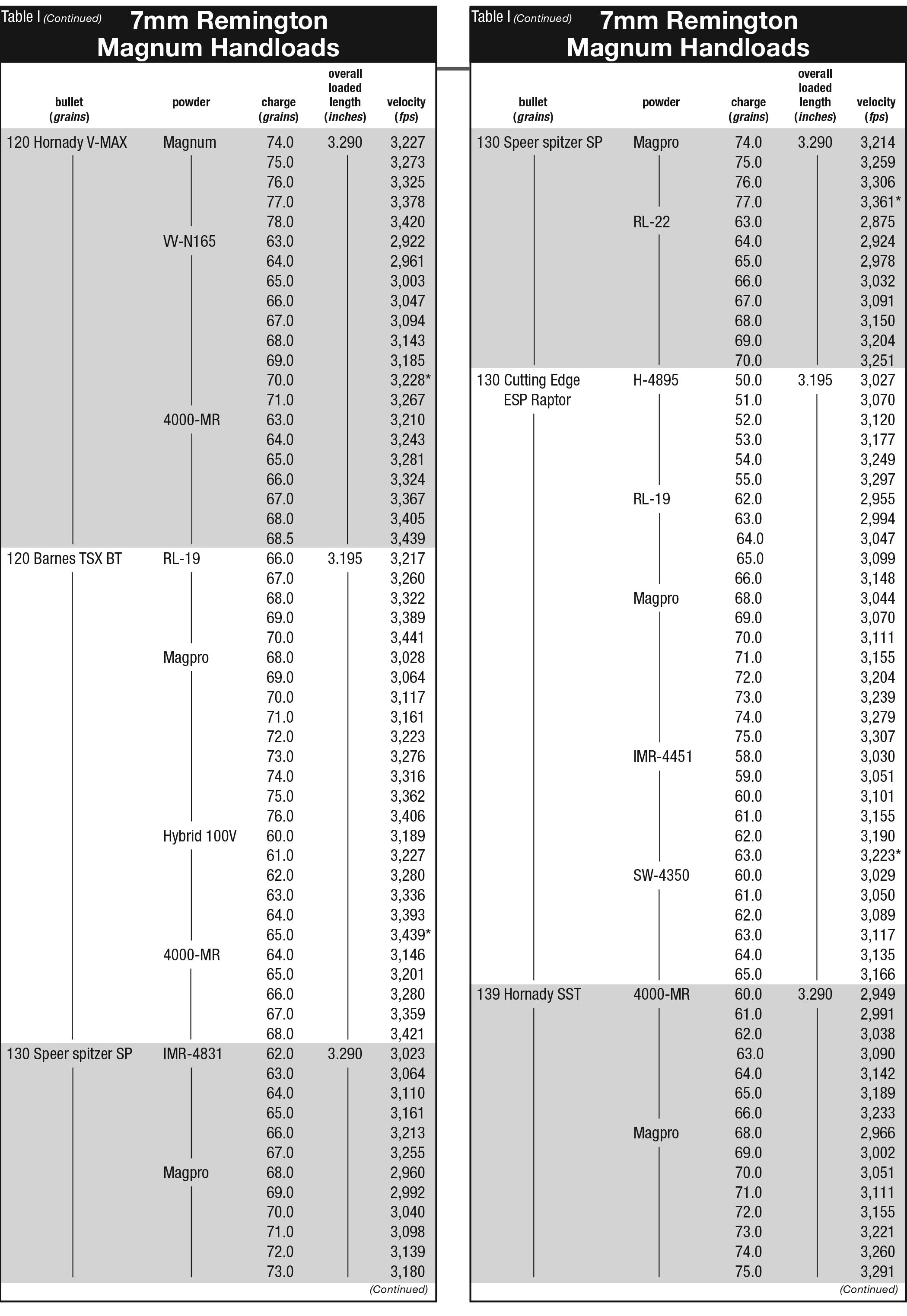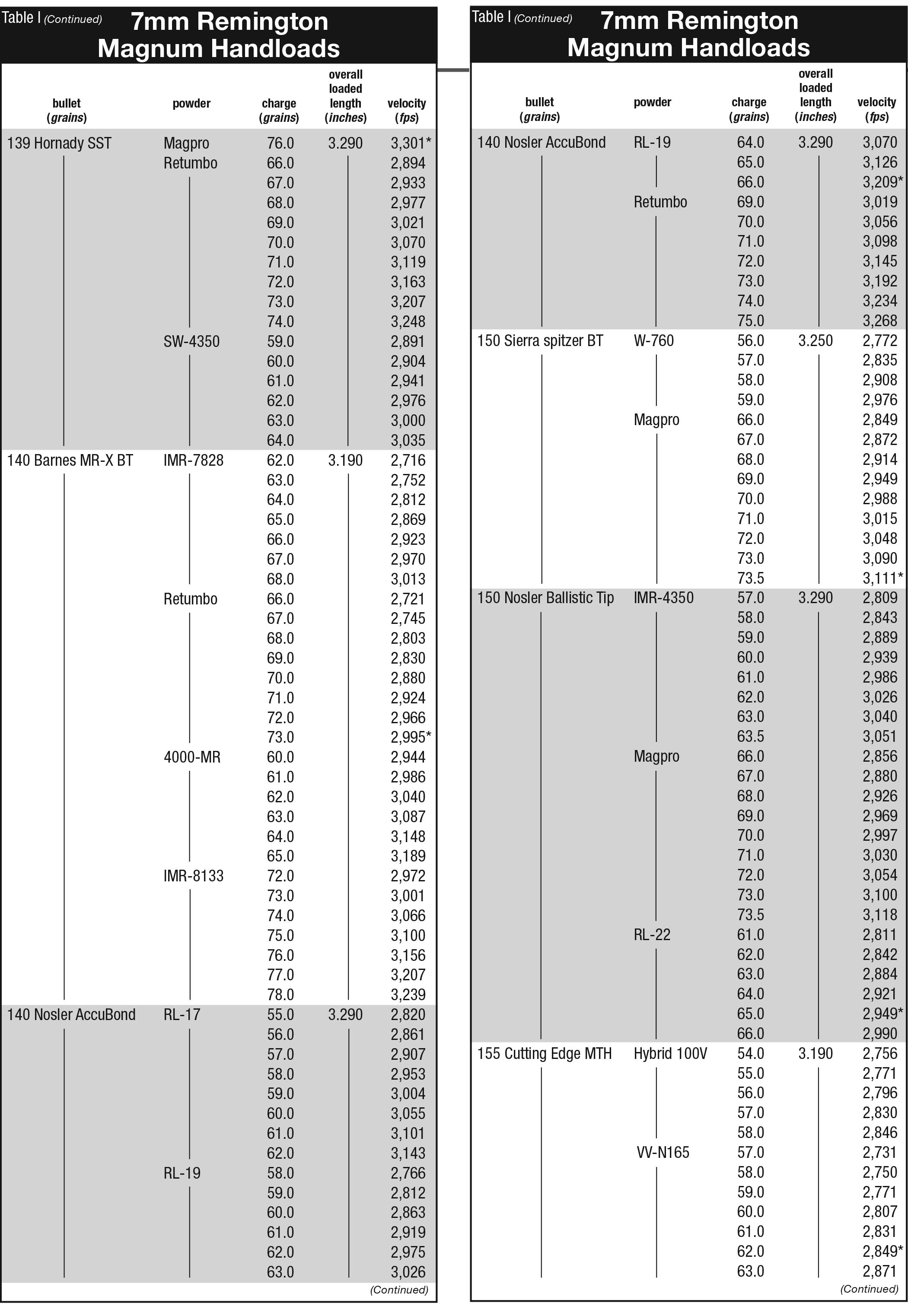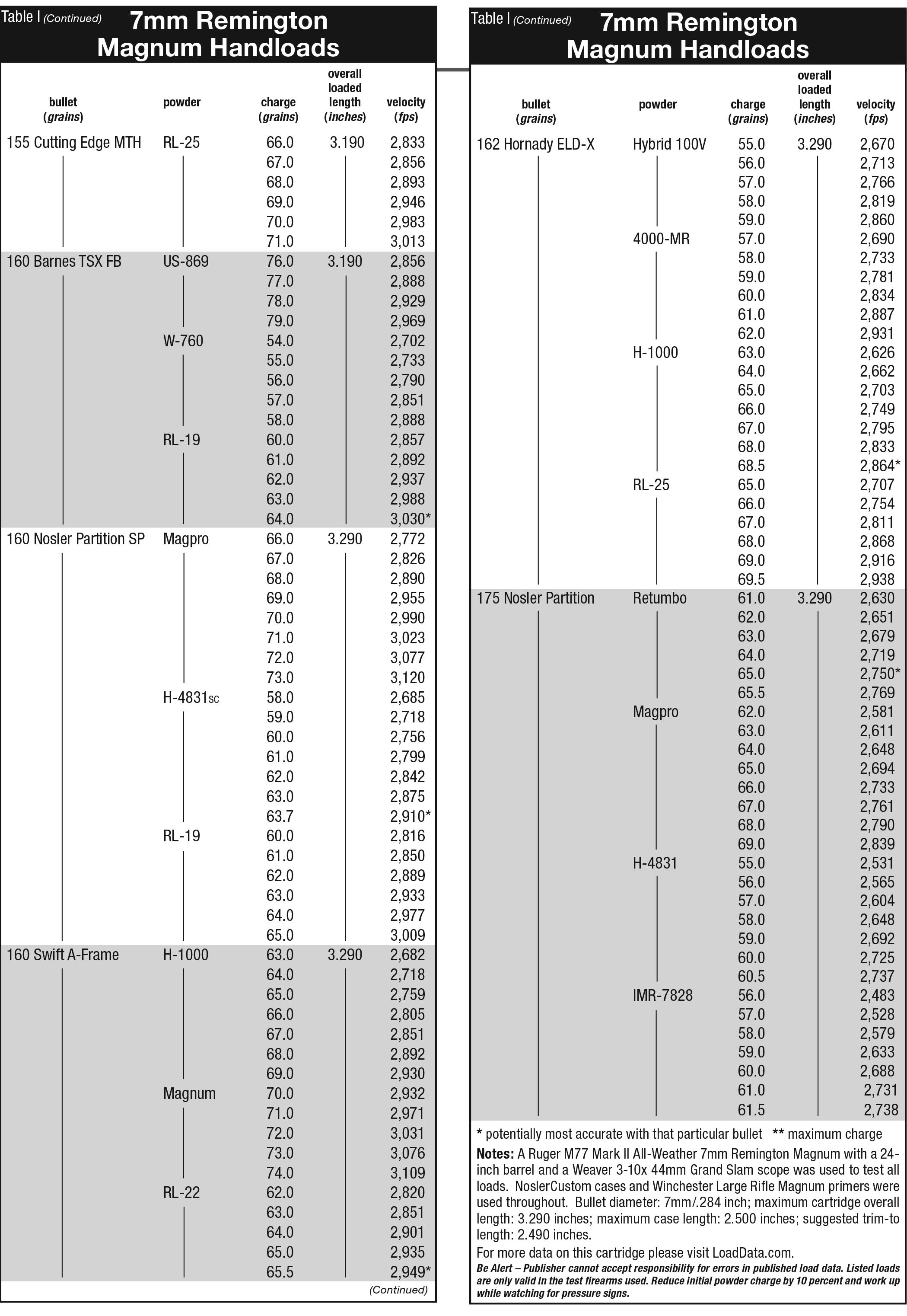7mm Remington Magnum (Pet Loads)
More Than 450 Handloads
feature By: Brian Pearce | December, 19

The 7mm Remington Magnum was introduced in 1962 along with the new Remington Model 700. Timing was perfect, as both were conducive to period trends by U.S. shooters and hunters, and sales soared. Remington’s “Seven Mag” remains a standard chambering whenever a new rifle is introduced. Its popularity has been continuous for the past 57 years. In spite of competition in the past couple of decades, even from Remington, it remains by far the most popular 7mm magnum in the U.S.

It has been in the winner’s circle of many long-range competitions but is most popular among hunters that need a cartridge capable of reliably taking big game while offering a flat trajectory, easily managed recoil (by most shooters) and without severe throat erosion.
While there had been many 7mm cartridges developed prior to World War II that delivered magnum-like performance, such as the .275 Belted Magnum (H&H), .280 Ross, .280 Jeffery and U.S. developed wildcats, it wasn’t until after the war that interest really soared, at least in the U.S. For example, around 1943 Roy Weatherby developed and offered the 7mm Weatherby Magnum, while the 7x61 Sharpe and Hart Super was first offered around 1953. Both were based on the .300/.375 H&H Belted Magnum case. While both gained some popularity, each suffered from being somewhat exotic, as they were not offered by major U.S. rifle and ammunition companies. (Weatherby has become a major rifle company today, but during this era it was a small company.)
Remington introduced the excellent .280 Remington in 1957, but it was poorly promoted, loaded to lower velocities than its full potential and had to compete with the well-established .270 Winchester. Notable post-war wildcats such as the

7mm Mashburn Super Magnum and 7mm-.300 Weatherby (both based on the belted-magnum case and required 3.600-inch length actions) failed to gain widespread acceptance.
Winchester recognized the demand for a high velocity, flat shooting, sub-.30-caliber cartridge and announced the .264 Winchester Magnum in 1958, chambered in the Winchester Model 70 Westerner. The parent case was the belted .300/.375 H&H Magnum shortened to 2.500 inch and featured a 25-degree shoulder. Overall cartridge length was 3.340 inches, which allowed it to function in standard .30-06-length actions and as a result was commonly referred to as a “short magnum.” Based on its modest recoil and flat trajectory it quickly became popular; however, that popularity was rather short lived for several reasons, including the need for a 26-inch barrel to accommodate its overbore nature, which resulted in a rather heavy rifle, which was contrary to period trends. Barrel life was not great, actual velocities

were well below advertised figures, bullet selection at that time was rather limited, etc.
Remington recognized the opportunity to develop a more versatile big-game magnum cartridge that would produce moderate recoil while correcting some of the .264’s shortcomings. By necking the .264 or .338 Winchester Magnum case to accept 7mm/.284-inch bullets along with very minute technical changes, the 7mm Remington Magnum was created. It boasted of significantly reduced throat erosion (when compared to the .264) and achieved its performance from a shorter 24-inch barrel. The larger caliber permitted a wider range of bullet weights for increased versatility, with early factory loads including a 150-grain bullet at 3,260 fps and 175 grain at 3,070 fps. Today is loaded with many additional bullet weights. The 7mm

bullets offer comparatively high ballistic coefficients that when combined with the high velocity of the 7mm Remington Magnum makes it a top choice for hunting in open country for mule deer, antelope, sheep, etc., but it is also better suited than the .264 for larger species such as elk and moose. While the 7mm Remington Magnum (RM) was properly promoted, it soon stood firmly on its own merits.
Interestingly, in 1996 the 7mm Shooting Times Westerner (STW) became a SAAMI cartridge with Remington offering factory loads in 1997. In 2001 Remington introduced the large capacity, beltless 7mm Remington Ultra Magnum (RUM) based on a modified .404 Jeffery case, which was followed by the 7mm Remington Short Action Ultra Magnum based on the same case but shortened to correspond with .308-length actions. None of these Remington cartridges have managed to impact the popularity of the 7mm RM to any important degree.
Other 7mm competition appeared from Dakota Arms with its 7mm Dakota being offered in the 1990s based on the beltless .404 Jeffery case with an overall length similar to the .30-06. John Lazzeroni offered the 7.21 Firehawk and 7.21 Firebird, but neither gained widespread acceptance. And of course, Winchester introduced the

7mm Winchester Short Magnum in 2001. While it was a good cartridge, for several reasons it was a failure. The .28 Nosler was introduced in 2015, and like the 7mm RUM is based on a modified .404 Jeffery case. However, it has had the shoulder moved back and changed to a 35-degree angle, and the maximum case length is cut to 2.590 inches while overall cartridge length is the same as the .30-06, 3.340 inches. The .28 Nosler is an outstanding cartridge that offers comparatively low extreme velocity spreads and is advertised as “The world’s most powerful 7mm commercial cartridge.” In spite of being proprietary, it has steadily gained in popularity but is still not a threat to the 7mm RM’s popularity.
Due to the 7mm RM offering an excellent blend of high velocity with high BC bullets,

My old friend, the late Bill Jordan, was one of the world’s finest shots with handgun, rifle and shotgun. He loved the “Seven Mag” and hunted with it all over the U.S. but also used it in Africa many times with excellent success on plains game, including bull eland that can exceed 2,000 pounds. Elmer Keith was likewise fond of the “Seven Remington” (as he called it) for hunting sheep, etc. It exceeded the performance of his pre-World War II 7mm wildcat, the .285 O.K.H.

I have been handloading the 7mm RM for more than 40 years and have always found it easy to assemble loads that are accurate and that easily duplicate and exceed factory load performance. While it is often used as a match cartridge with heavy, long bullets, the loads listed here were developed primarily for hunters. Many of the new powders and bullets gave noteworthy performance.
While I have several rifles chambered for the 7mm RM, a Ruger M77 Mark II All-Weather that features a 24-inch stainless hammer-forged barrel with a 1:9.5 twist rate was used. In spite of being rather homely, it has proven accurate and the action is highly reliable, which is very important while in the process of developing data. It is important to note that it also posts velocities that are typically within 10 to 50 fps of factory load advertised figures, but in some instances it actually exceeds advertised velocities.
Friend Allan Jones, the editor of the Speer Reloading Manuals No. 12, No. 13 and No. 14, reported that “there is a great deal of velocity variation among sporters in this caliber.” He continues that “Rifles in the Speer’s lab’s collection posted velocities varying from 400 ft/sec under to 300 ft/sec over those posted by the SAAMI pressure barrel with the same ammo.” While I have not experienced the incredible 700-fps swings in sporter rifles that the Speer lab has, I have seen 300- to 400-fps swings with identical loads between Remington, Weatherby, Winchester, Ruger, Interarms and Sako rifles, each featuring 24-inch barrels.

While shooters will usually experience longer case life when neck sizing cases, when assembling hunting ammunition it is recommended to full length size cases to assure reliable chambering.
It should be noted that cases from Remington, Winchester, Federal, Hornady, Norma and NoslerCustom were checked for water capacity. There was almost a 4.0-grain variance between cases with the least capacity (Remington) and those with the largest capacity (Winchester). Naturally, loads assembled in cases with the least capacity will generate maximum pressure levels before cases that have a larger capacity. NoslerCustom cases were used to develop the accompanying data and are weight sorted, fully sized, trimmed, primer pockets uniformed and ready to load. To fire the extensive data contained here, 500 cases were fired and reloaded multiple times using RCBS dies.
Maximum average pressure is currently listed at 61,000 psi (using the piezoelectric pressure measurement system), while the older (and less precise) copper crusher measurement system is listed at 52,000 CUP. For the handloader, a chronograph is an important tool, especially when assembling loads for the 7mm RM. If velocities are exceeding expected velocities then that particular rifle is producing greater pressures. As a result, maximum listed loads may be producing excess pressures in that particular rifle and should not be used.
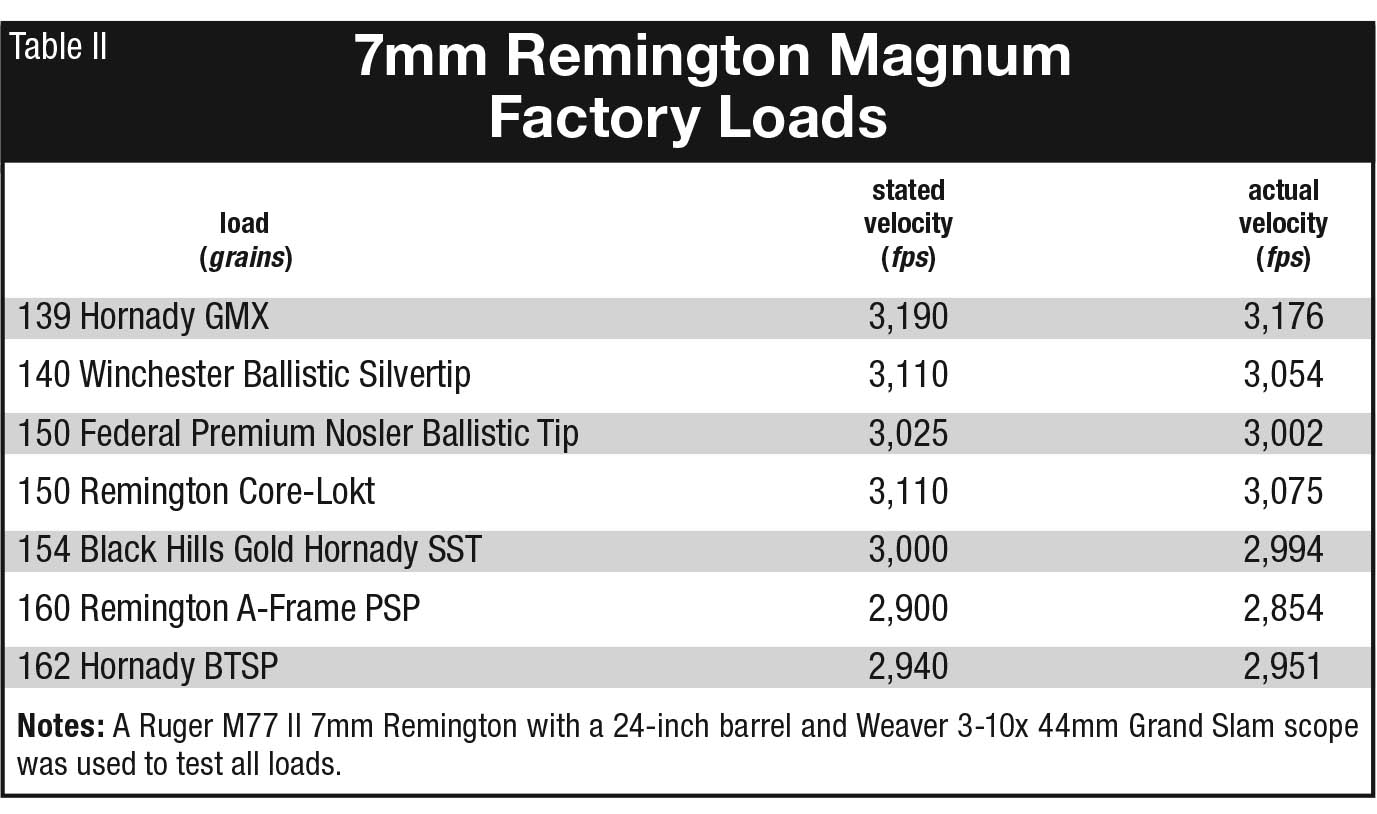
Most 7mm RM sporting rifles feature a 1:9 to 1:9.5 twist and will generally stabilize bullets weighing from 100 to 175 grains. It should be noted that many heavyweight bullets suffer from yaw, wherein the bullet rotates around its axis at a tiny angle in relation to its flight. Usually the nose is on the axis of the bullet’s path while the base spirals around the axis. This yaw usually “settles out” or fully stabilizes, wherein the bullet’s tip and the base are on the same axis, at around 100 yards. As a result, I have had several rifles that shoot nearly identical groups at 200 yards as they do at 100 yards.
Varmint hunters will appreciate the data developed with the Sierra 100 grain, Speer 110-grain TNT HP, Nosler 120-grain Ballistic Tip and Hornady 120-grain V-MAX bullets. Select powders were able to push bullets from 3,500 to 3,700 fps, which are devastating to pests while hitting coyotes and wolves with authority and offering an especially flat trajectory at normal hunting distances.
Expanding monolithic bullets have gained much popularity among big-game hunters in recent years, such as the Barnes TSX, TTSX and MR-X. Also included are the Hornady GMX and the Cutting Edge ESP Raptor. Generally speaking, these bullets produce their best accuracy when seated deeper than conventional cup-and-core designs. When fine tuning a load for best accuracy for a given rifle, as a starting point I typically seat bullets .050 inch off the leade (or lands) then check them for accuracy. Usually the accuracy “sweet spot” will be found between .040 to .090 inch off the leade. Incidentally, the Cutting Edge 115- and 130-grain ESP Raptor bullets are specified to be used with a 1:9 or faster twist. They worked well in the test rifles’ 1:9.5 twist barrel; however, their stability at long range was not determined.

Most of my hunting with the 7mm RM has been in open country using virtually every readily available commercial bullet weighing from 150 to 162 grains. I prefer the 160- to 162-grain bullets for most applications and at reasonable distances. I have had excellent results with the Nosler 160 Partition; however, the 160-grain AccuBond offers a ballistic edge while providing excellent terminal performance on deer-sized game. I have not had a chance to use the relatively new Hornady 162-grain ELD-X bullet in the field; however, it boasts of an impressive .631 G1 BC. Terminal performance is expected to be on par with other ELD-X bullets that I have used, all of which is certain to make it an outstanding choice for open country hunting.
For larger game such as moose, eland, etc., the Barnes 160-grain bullet and Nosler 175-grain Partition are proven choices.
Select spherical powders were used to develop handload data. Top choices include Winchester 760, Alliant 4000-MR, Accurate Magpro, Ramshot Magnum, Hodgdon U.S.869 and Hybrid 100V (technically a combined technology of extruded and spherical powders). I was impressed with the overall performance of each, as they often yielded top velocities that fully equaled and often exceeded factory load velocities while producing good accuracy.
They also have the advantage of being thrown from a powder measure with very little weight variance. All of this explains why several major ammunition companies now load spherical powders in their 7mm RM factory ammunition. Almost without exception, the lowest extreme velocity spreads (often very impressive) and best accuracy were observed with maximum or very near maximum charges. It should be noted that suggested “start” loads should not be further reduced or erratic ignition and hang-fires can occur.
Extruded powders have long been a favorite with 7mm RM handloaders but are also popular with factories. Traditional powders include H-4831, H-4350, IMR-4831 and IMR-7828 that still perform very well. However, the competition has become fierce. For example, Alliant Reloder 19, 22 and 25 powders offer top velocities, low extreme spreads and are clean burning. New powders from Hodgdon such as H-1000, Retumbo and H-4831SC are popular among hunters and long-range shooters due to their “extreme” technology, accuracy, etc. I was pleased with the overall performance of the relatively new IMR-4451, IMR-4955 and IMR-8133 “Enduron” powders that are temperature insensitive, clean burning and minimize copper fouling.
The 7mm RM typically utilizes between 60.0 to 78.0 grains of powder, so it is always suggested to use a large rifle magnum primer to assure proper ignition of all propellant types and at all temperatures. Winchester Large Rifle Magnum primers were used to develop the accompanying loads.
With new powders and bullets the 7mm Remington Magnum offers new levels of accuracy, velocity and terminal performance, which makes it a better and more interesting cartridge than any time in its 57-year history.


